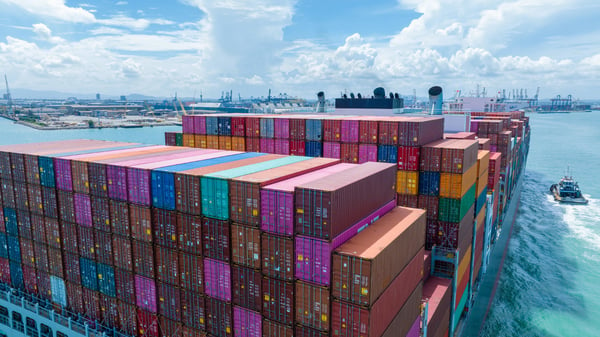CBAM is a new EU climate policy that requires importers of certain goods to report carbon emissions and purchase CBAM certificates. There are good reasons to understand how your business is affected and, more importantly, what actions you need to take in relation to the EU's carbon adjustment mechanism. We help to clarify the main issues related to the new climate tariff.
The Carbon Border Adjustment Mechanism (CBAM) requires importers into the EU to report carbon emissions and purchase CBAM certificates. As the name suggests, it is a climate tariff in the form of a carbon adjustment mechanism. Companies that fail to comply face heavy fines and sanctions.
So what do you need to know about the EU climate tariff? Which products are subject to CBAM reporting, what is the timeline for implementation and what can you do as a business to stay ahead? These are some of the questions that we get to the bottom of here.
What is CBAM?
The Carbon Border Adjustment Mechanism is the EU's solution to the problem of carbon leakage. This refers to the situation where companies, for cost reasons linked to climate policy, either move production to or buy from countries with lower emission standards.
The new EU climate tariff is intended to mirror the EU Emissions Trading System (ETS), which prices carbon emissions within the EU. The ETS provides incentives for companies to invest in emission reduction measures. Until now, production outside the EU has not been subject to climate rules, which can disadvantage domestic production. This is why this carbon adjustment mechanism is being set up.
CBAM aims to price carbon emissions from non-EU production more fairly (with the exception of EEA countries). In short, it should not pay to circumvent climate policy within the EU.
CBAM should also be seen in the context of the Paris Agreement and the goal of being climate neutral by 2050. Legislation in the form of the EU's climate tariff is one tool in the toolbox to achieve this goal.
Objectives and goods covered by CBAM
The three main objectives of the new carbon adjustment mechanism are
- Reducing carbon emissions.
- Fair pricing of carbon emissions in the production of carbon-intensive goods imported into the EU
- Encouraging cleaner industrial production by calculating embedded emissions in line with the Paris Agreement and the EU Fit for 55 package.
These are carbon-intensive industries. Currently, the following seven products are covered by the climate rules
- Iron
- Steel
- Cement
- Fertilizers
- Aluminum
- Hydrogen gas
- Electricity
However, this list will grow as the legislation is updated. From 2026 onwards, the EU will review other products to be added to the CBAM. And the plan is for all ETS products to be included from 2030 onwards, including installations and operators in electricity and heat production, industrial manufacturing, aviation and maritime transport.

Implementing CBAM in two steps
The implementation of the EU ETS will take place in two different phases. The first phase is a transitional period from 1 October 2023 to 31 December 2025. During this period, you must submit quarterly reports on your company's emissions to the CBAM Transitional Registry. The reports must be submitted one month after the end of each quarter. The last report will thus be submitted in the first quarter of 2026. However, there are no financial obligations during the transition period to the new climate rules.
The second phase is the full implementation, starting on January 1, 2026, when reporting will be required on an annual basis and companies will have to purchase CBAM certificates to cover emissions.
Reporting, registration and payment
In concrete terms, the requirements for you are as follows:
- Reporting. Information on imports. Calculations of embedded direct and indirect emissions.
- Registration. This is done via the CBAM Portal in the CBAM Transitional Registry. Via the portal you will also be able to pay for certificates.
- Payment of certificates. Sales are made via the Common Central Platform (CCP). Each certificate corresponds to one ton of CO2 emissions. The first time this happens is for the calendar year 2026, by 31 May 2027 at the latest. The certificates have a limited validity period and no compensation is paid if they are not used.
So what is the price of a CBAM certificate? It will be based on the average weekly price of allowances in the ETS. As the free allocation of certificates decreases, the price will increase. From 2030 onwards, all ETA goods will be subject to the carbon adjustment mechanism.
Reading tip: CSRD and CSDDD: More efficient reporting with the same system support
Consequences of not complying with CBAM
As an importer, not complying with CBAM can have serious consequences. Missing, incorrect or incomplete carbon reporting in accordance with the climate rules can lead to financial penalties, correction requirements and fines.
The penalty for not reporting embedded emissions is calculated from €10 to €50 per tonne, depending on the severity and duration of the non-compliance. This could mean that you will not be granted the status of approved CBAM declarant and will not be allowed to import the goods from 2026 onwards.
How your business can prepare for CBAM
CBAM means new requirements for many businesses. Regardless of the extent of the impact on your business, it is wise to prepare well in advance. Not only does it give you better control over your reporting, but it also gives you the opportunity to streamline your work and strengthen your sustainability efforts.
See how Stratsys can help you take the next step in your sustainability work: Read more about ESG Due Diligence



